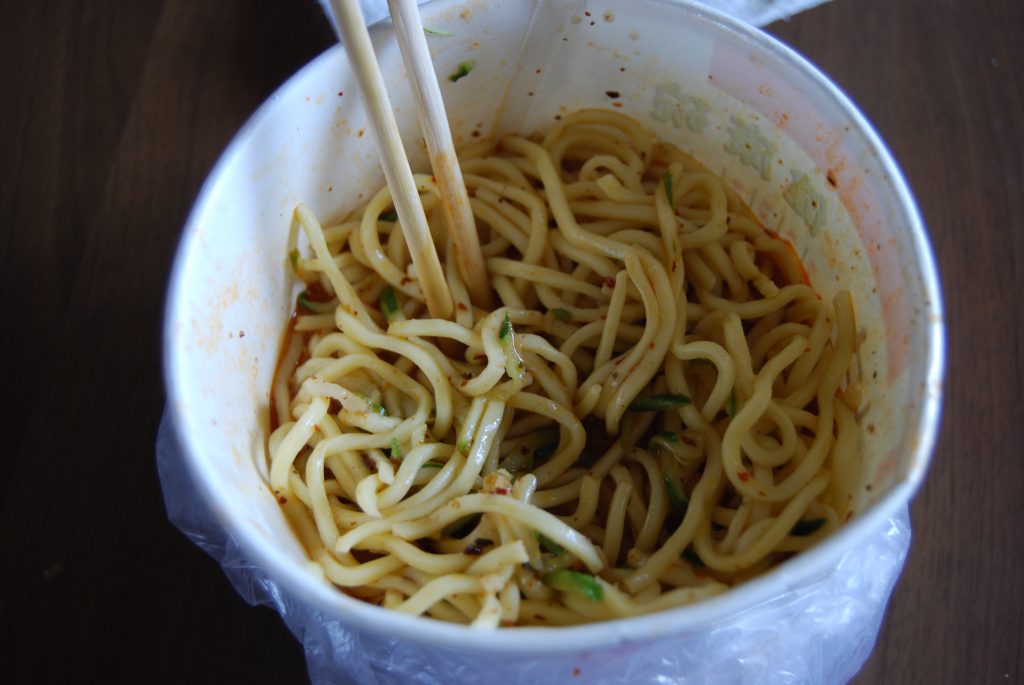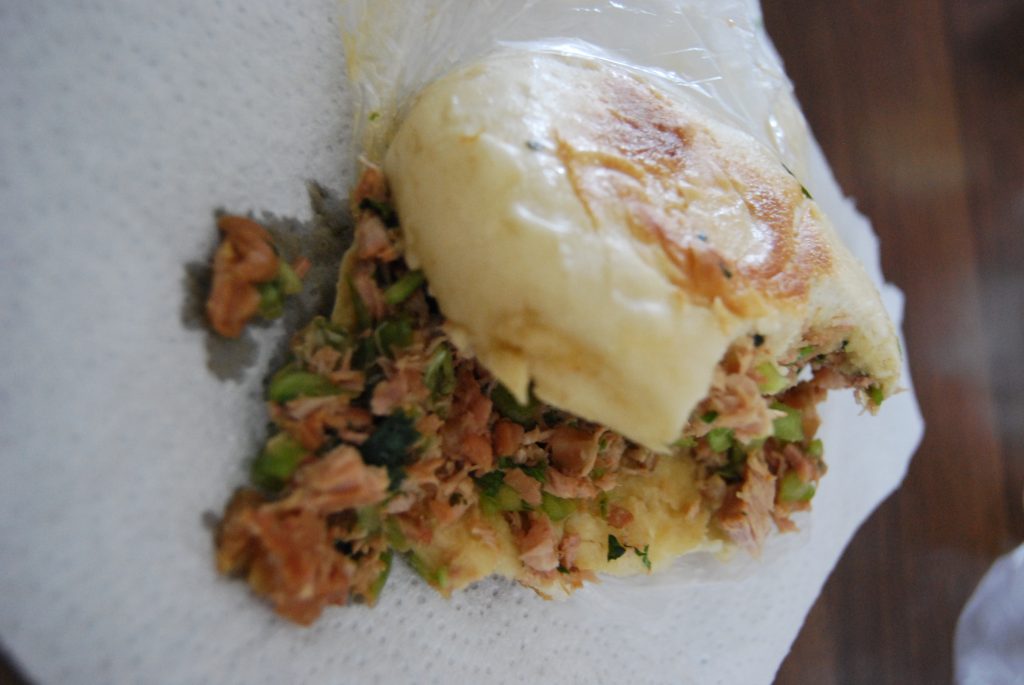Real Chinese Food – Lunch Posted by sasha on Jan 13, 2016 in Uncategorized
Forget those crab rangoons and General Tso’s chicken, because we’re discovering real Chinese food here on the blog. We’ve already talked about what’s on the menu for breakfast in China, so now it’s time to take a look at how the Chinese do lunch (午餐 – wǔ cān).
A Fast or Big Meal

驴肉火烧 (donkey meat sandwich) – a quick meal.
Depending on the circumstances, lunch in China is typically either a quick meal or an epic feast. For the old hundred names (老百姓 – lǎo bǎi xìng – “common people”), lunchtime is but a short break in an otherwise busy workday. With less than an hour, most people will simply bring some food from home or grab a quick bite from a restaurant near their workplace. Clustered around every office building or shopping center, you’ll always find tons of hole-in-the-wall restaurants cooking up fast and cheap food for the busy workers in the area. In some office buildings and in almost every school there’s a canteen with tons of ready-made items to choose from for a fast and easy lunch.
On the opposite end of the spectrum, those with time (and money) on their hands tend towards a more relaxing, lavish lunch. If they have the resources, people tend to go big for lunch. This is especially true in the business world, where marathon meals accompanied by copious amounts of bai jiu are not uncommon. It’s a miracle anything ever gets done after noon, because a Chinese business lunch leaves you incredibly full, tipsy, and sleepy. The one and only time when I did a “white guy in a tie” day of phony business in China, we had a totally over-the-top lunch in a fancy restaurant along with plenty of booze. Needless to say, the afternoon meetings were a bit more fun, but also harder to stay awake through.
The Tri-fecta

凉面 (cold noodles)
For most people, lunch will be some form of the Chinese tri-fecta of staple foods – noodles (面 – miàn), rice (米饭 – mǐ fàn), or dumplings (饺子 – jiǎo zi). While that may not seem like a lot of choices, there are so many varieties of all three that you can realistically have a completely different lunch every day of the week. Telling a Chinese person that all noodles are the same is like telling an American that all hot dogs are the same – it’s just not true. You’ve got flour noodles, rice noodles, hand-pulled noodles, fried noodles, the list goes on and on. Ditto for dumplings – they can be steamed, boiled, fried, and filled in a variety of ways. Why not try making them yourself by following our Chinese recipe for dumplings? As far as the rice goes, it’s common to order a classic Chinese dish on rice (盖饭 – gài fàn). You get a smaller portion than just ordering the dish on its own, but for around 10-15 RMB it’s a cheap and filling lunch.
Fast Food Options

肉夹馍 (pork sandwich)
It’s hard to make time for lunch in a busy day, so fast food is very popular in the afternoon. Both local and foreign options draw quite the crowd for lunch. On the Chinese end, fast foods are found from street vendors or from small restaurants (some family owned and some chain). Some of my favorite Chinese fast foods for lunch are the rou jiao mo (what some would call a Chinese hamburger), or xiao long bao (steamed stuffed buns). My personal favorite is a donkey meat sandwich. It sounds strange, but it’s delicious and tastes basically like corned beef. Check out a funny video I made of this great lunch snack and see for yourself:
If you’ve ever traveled in China, you’ve probably noticed that there are also tons of KFC (肯德基 – kěn dé jī) and McDonald’s (麦当劳 – mài dāng láo) restaurants, especially in bigger cities. Both American chains have tweaked their menus to appeal to Chinese tastes, and both offer lunch specials for 15-20 RMB. I’m not the biggest fan of either, but I must admit sometime those lunch deals bring me in the door, especially when I need a break from rice and noodles.
Vocabulary
To help you order your lunch in Chinese, here are some common things you’ll see on the menu:
-
flour noodles (面条 – miàn tiáo)
-
fried noodles (炒面 – chǎo miàn)
-
cold noodles (凉面 – liáng miàn)
-
hand-pulled noodles (拉面 – lā miàn)
-
knife-cut noodles (刀削面 – dāo xiāo miàn)
-
rice noodles (米线 – mǐ xiàn) or (米粉 – mǐ fěn)
-
kung pao chicken (宫保鸡 – gōng bǎo jī dīng)
-
scrambled eggs and tomatoes (西红柿鸡蛋 – xī hóng shì jī dàn)
-
fish-scented pork (鱼香肉丝 – yú xiāng ròu sī)
-
“three treasures of the Earth” (地三鲜 – dì sān xiān)
-
spicy diced chicken (辣子鸡丁 – là zǐ jī dīng)
-
on rice (盖饭 – gài fàn)
-
dumplings (饺子 – jiǎo zi)
-
wontons (馄饨 – hún tún)
-
Chinese hamburger (肉夹馍 – ròu jiā mó)
-
donkey meat sandwich (驴肉火烧 – lǘ ròu huǒ shāo)
-
xiao long bao (小笼包 – xiǎo lóng bāo)

Build vocabulary, practice pronunciation, and more with Transparent Language Online. Available anytime, anywhere, on any device.
About the Author: sasha
Sasha is an English teacher, writer, photographer, and videographer from the great state of Michigan. Upon graduating from Michigan State University, he moved to China and spent 5+ years living, working, studying, and traveling there. He also studied Indonesian Language & Culture in Bali for a year. He and his wife run the travel blog Grateful Gypsies, and they're currently trying the digital nomad lifestyle across Latin America.




Leave a comment: